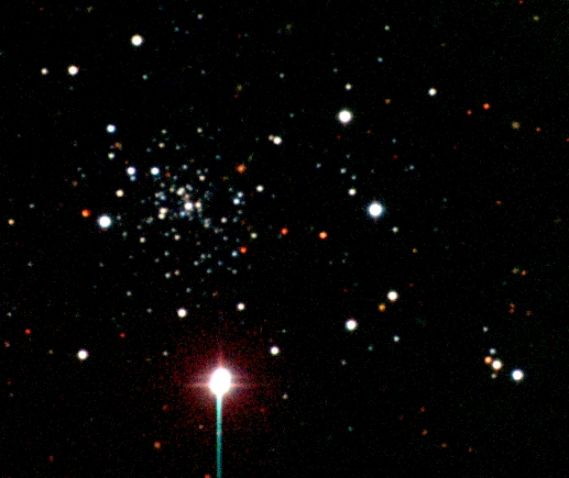Credit & Copyright: M. Siegel &
S. Majewski (UVA),
C. Gallart (Yale),
K. Cudworth (Yerkes),
M. Takamiya (Gemini),
Las Campanas Observatory
Explanation:
Globular star cluster
Palomar 13
has roamed the halo of our
Milky Way Galaxy for the last 12 billion years.
The apparently
sparse
cluster of stars just left of center in
this composite color digital image,
it is one of the smallest, faintest
globular
clusters known.
(The bright foreground star near bottom
is unrelated and creates the spiky imaging artifacts.)
Observations spanning forty years indicate
that Palomar 13's
galactic halo orbit
is a highly eccentric one which, every one or two billion
years, brings it relatively close to the galactic center.
With each close approach to the
Milky Way's central regions,
gravitational tidal forces
strip away
the delicately bound cluster stars.
In fact, detailed present day studies offer evidence
for a dramatic end to this dwindling cluster's tidal
tug of war.
Palomar 13's latest close approach was only
about 70 million years ago.
But, when Palomar 13 again approaches the galaxy, it
could well turn out to be
the cluster's
last stand.
Las Campanas Observatory
1999 2000 2001 2002 2003 2004 2005 2006 2007 2008 2009 2010 2011 2012 2013 2014 2015 2016 2017 2018 2019 2020 2021 2022 2023 2024 2025 |
Январь Февраль Март Апрель Май Июнь Июль Август Сентябрь Октябрь Ноябрь Декабрь |
NASA Web Site Statements, Warnings, and Disclaimers
NASA Official: Jay Norris. Specific rights apply.
A service of: LHEA at NASA / GSFC
& Michigan Tech. U.
|
Публикации с ключевыми словами:
globular cluster - palomar 13 - Milky Way - Шаровое скопление - Млечный Путь - Паломар 13
Публикации со словами: globular cluster - palomar 13 - Milky Way - Шаровое скопление - Млечный Путь - Паломар 13 | |
См. также:
Все публикации на ту же тему >> | |
